engine YAMAHA YFM350R 2003 Notices Demploi (in French)
[x] Cancel search | Manufacturer: YAMAHA, Model Year: 2003, Model line: YFM350R, Model: YAMAHA YFM350R 2003Pages: 380, PDF Size: 15.64 MB
Page 172 of 380
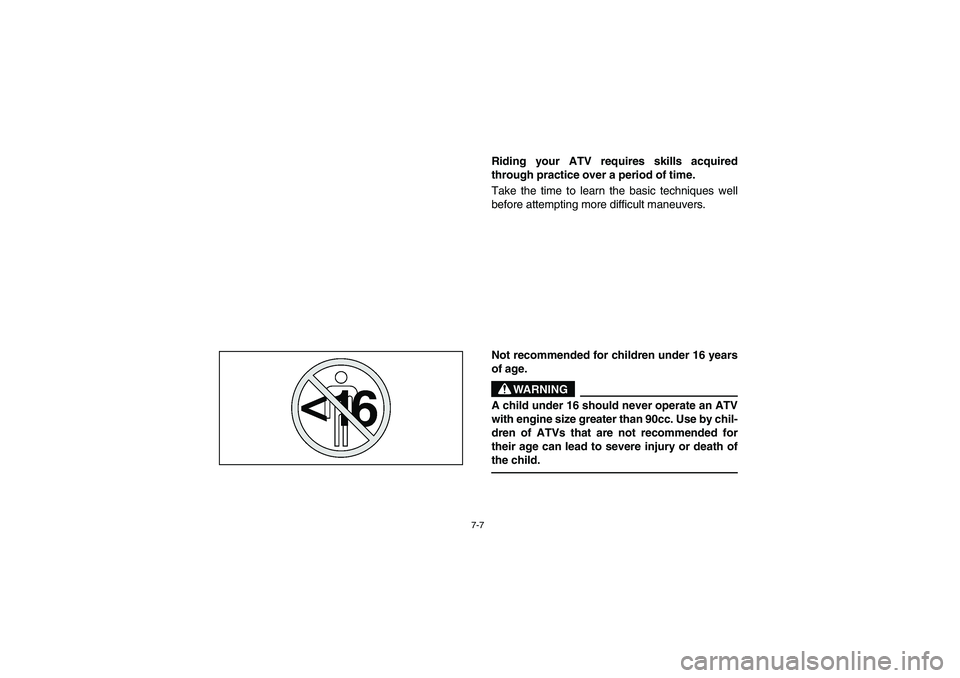
7-7
Riding your ATV requires skills acquired
through practice over a period of time.
Take the time to learn the basic techniques well
before attempting more difficult maneuvers.
Not recommended for children under 16 years
of age.
WARNING
_ A child under 16 should never operate an ATV
with engine size greater than 90cc. Use by chil-
dren of ATVs that are not recommended for
their age can lead to severe injury or death of
the child. _
U5NF62.book Page 7 Wednesday, May 8, 2002 1:40 PM
Page 190 of 380
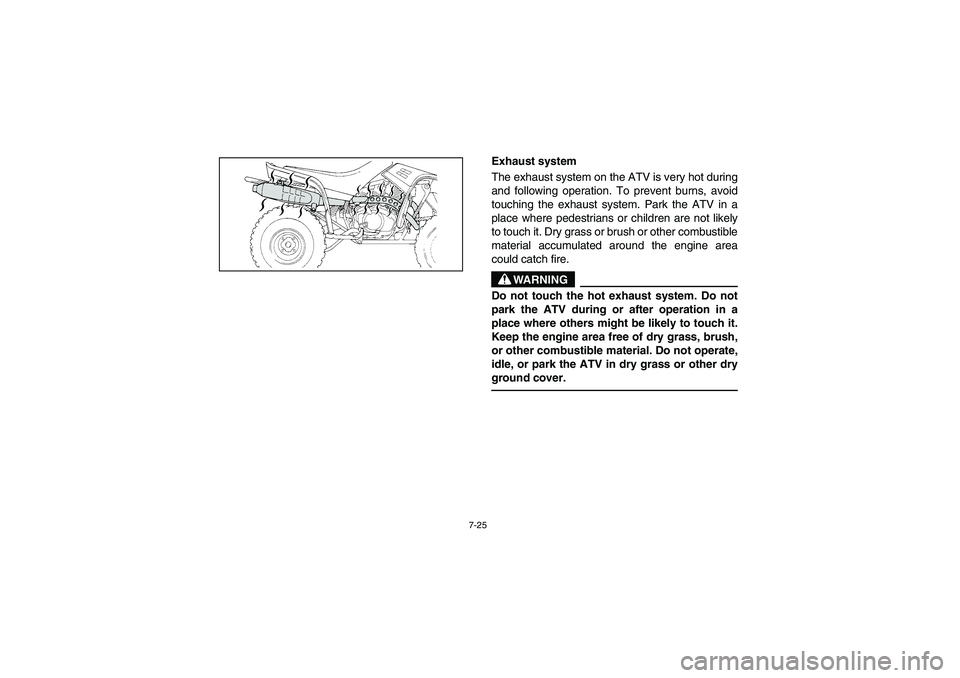
7-25
Exhaust system
The exhaust system on the ATV is very hot during
and following operation. To prevent burns, avoid
touching the exhaust system. Park the ATV in a
place where pedestrians or children are not likely
to touch it. Dry grass or brush or other combustible
material accumulated around the engine area
could catch fire.
WARNING
_ Do not touch the hot exhaust system. Do not
park the ATV during or after operation in a
place where others might be likely to touch it.
Keep the engine area free of dry grass, brush,
or other combustible material. Do not operate,
idle, or park the ATV in dry grass or other dry
ground cover. _
U5NF62.book Page 25 Wednesday, May 8, 2002 1:40 PM
Page 198 of 380
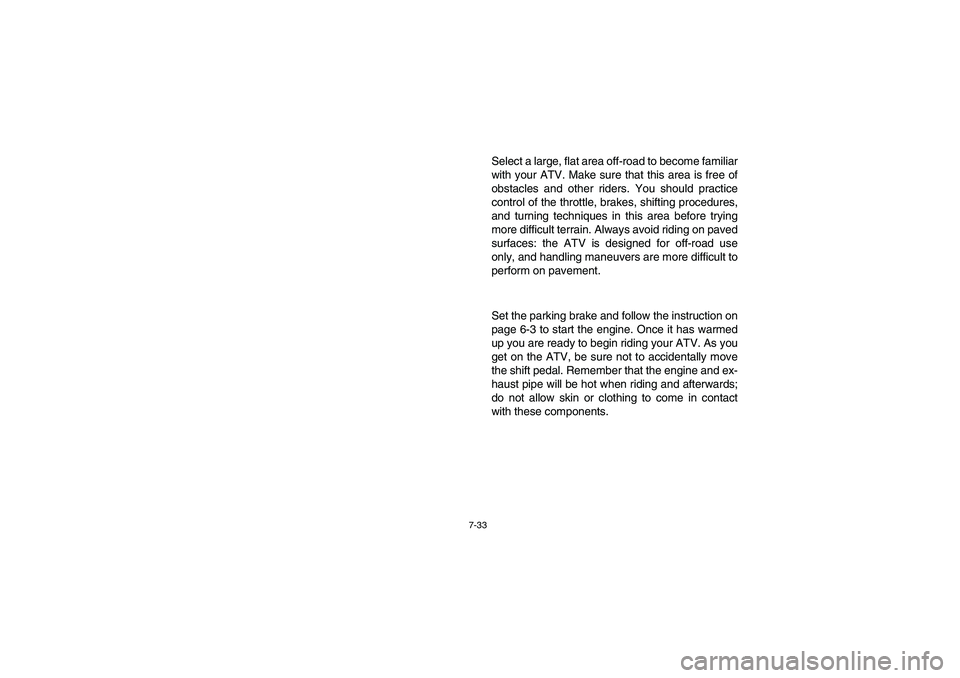
7-33
Select a large, flat area off-road to become familiar
with your ATV. Make sure that this area is free of
obstacles and other riders. You should practice
control of the throttle, brakes, shifting procedures,
and turning techniques in this area before trying
more difficult terrain. Always avoid riding on paved
surfaces: the ATV is designed for off-road use
only, and handling maneuvers are more difficult to
perform on pavement.
Set the parking brake and follow the instruction on
page 6-3 to start the engine. Once it has warmed
up you are ready to begin riding your ATV. As you
get on the ATV, be sure not to accidentally move
the shift pedal. Remember that the engine and ex-
haust pipe will be hot when riding and afterwards;
do not allow skin or clothing to come in contact
with these components.
U5NF62.book Page 33 Wednesday, May 8, 2002 1:40 PM
Page 200 of 380
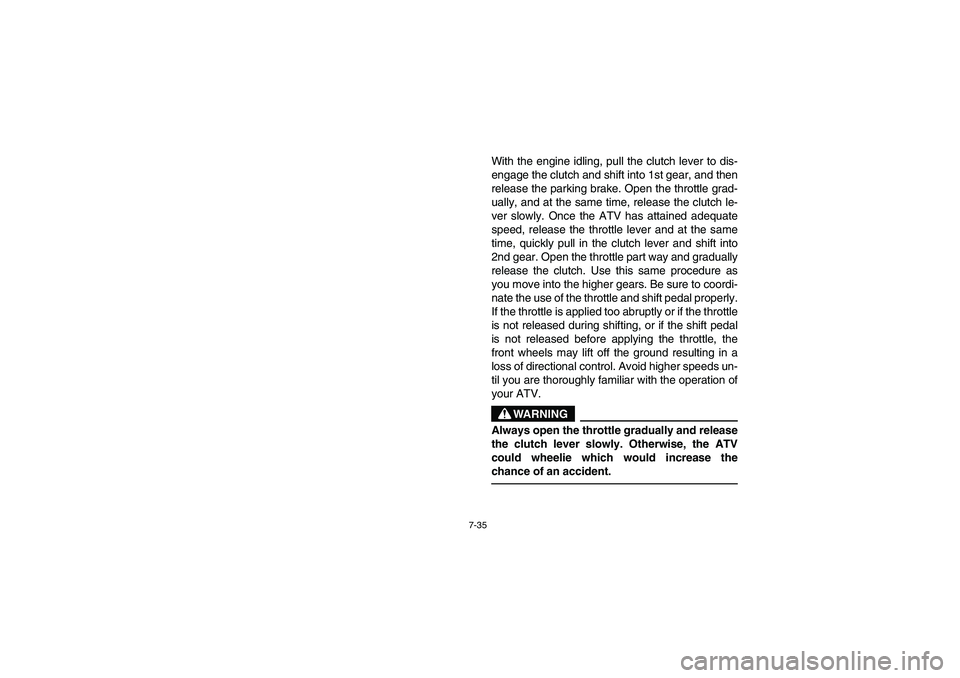
7-35
With the engine idling, pull the clutch lever to dis-
engage the clutch and shift into 1st gear, and then
release the parking brake. Open the throttle grad-
ually, and at the same time, release the clutch le-
ver slowly. Once the ATV has attained adequate
speed, release the throttle lever and at the same
time, quickly pull in the clutch lever and shift into
2nd gear. Open the throttle part way and gradually
release the clutch. Use this same procedure as
you move into the higher gears. Be sure to coordi-
nate the use of the throttle and shift pedal properly.
If the throttle is applied too abruptly or if the throttle
is not released during shifting, or if the shift pedal
is not released before applying the throttle, the
front wheels may lift off the ground resulting in a
loss of directional control. Avoid higher speeds un-
til you are thoroughly familiar with the operation of
your ATV.
WARNING
_ Always open the throttle gradually and release
the clutch lever slowly. Otherwise, the ATV
could wheelie which would increase the
chance of an accident. _
U5NF62.book Page 35 Wednesday, May 8, 2002 1:40 PM
Page 202 of 380
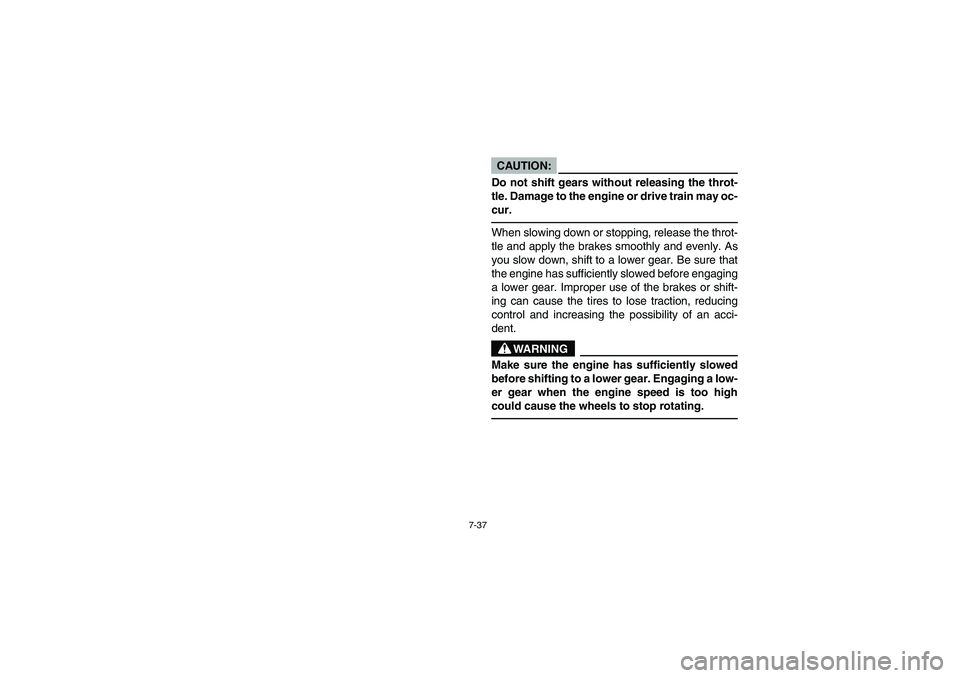
7-37
CAUTION:_ Do not shift gears without releasing the throt-
tle. Damage to the engine or drive train may oc-
cur. _When slowing down or stopping, release the throt-
tle and apply the brakes smoothly and evenly. As
you slow down, shift to a lower gear. Be sure that
the engine has sufficiently slowed before engaging
a lower gear. Improper use of the brakes or shift-
ing can cause the tires to lose traction, reducing
control and increasing the possibility of an acci-
dent.
WARNING
_ Make sure the engine has sufficiently slowed
before shifting to a lower gear. Engaging a low-
er gear when the engine speed is too high
could cause the wheels to stop rotating. _
U5NF62.book Page 37 Wednesday, May 8, 2002 1:40 PM
Page 220 of 380
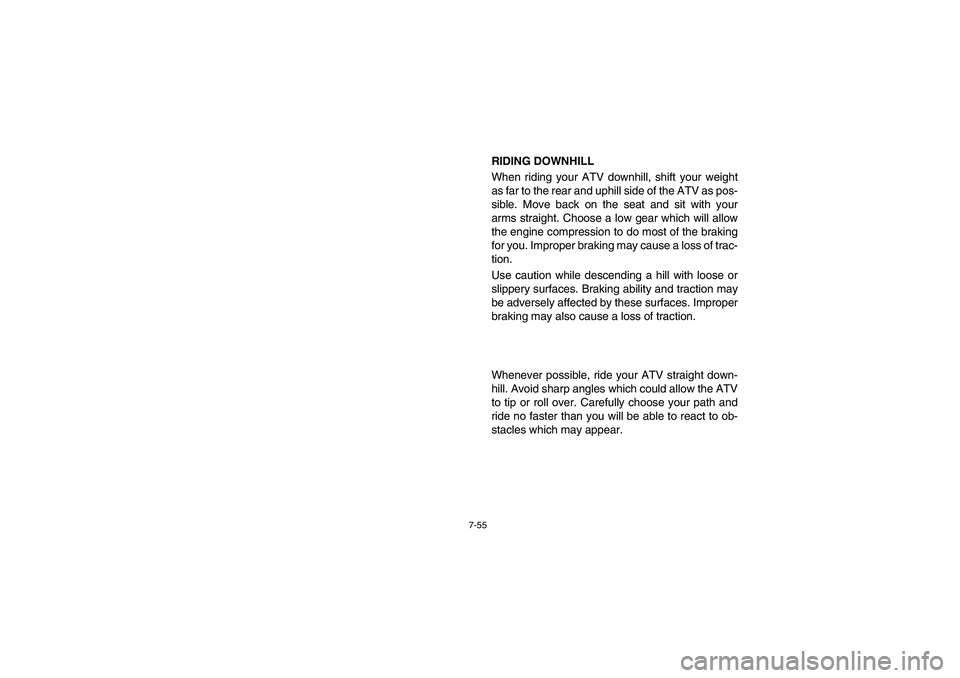
7-55
RIDING DOWNHILL
When riding your ATV downhill, shift your weight
as far to the rear and uphill side of the ATV as pos-
sible. Move back on the seat and sit with your
arms straight. Choose a low gear which will allow
the engine compression to do most of the braking
for you. Improper braking may cause a loss of trac-
tion.
Use caution while descending a hill with loose or
slippery surfaces. Braking ability and traction may
be adversely affected by these surfaces. Improper
braking may also cause a loss of traction.
Whenever possible, ride your ATV straight down-
hill. Avoid sharp angles which could allow the ATV
to tip or roll over. Carefully choose your path and
ride no faster than you will be able to react to ob-
stacles which may appear.
U5NF62.book Page 55 Wednesday, May 8, 2002 1:40 PM
Page 244 of 380
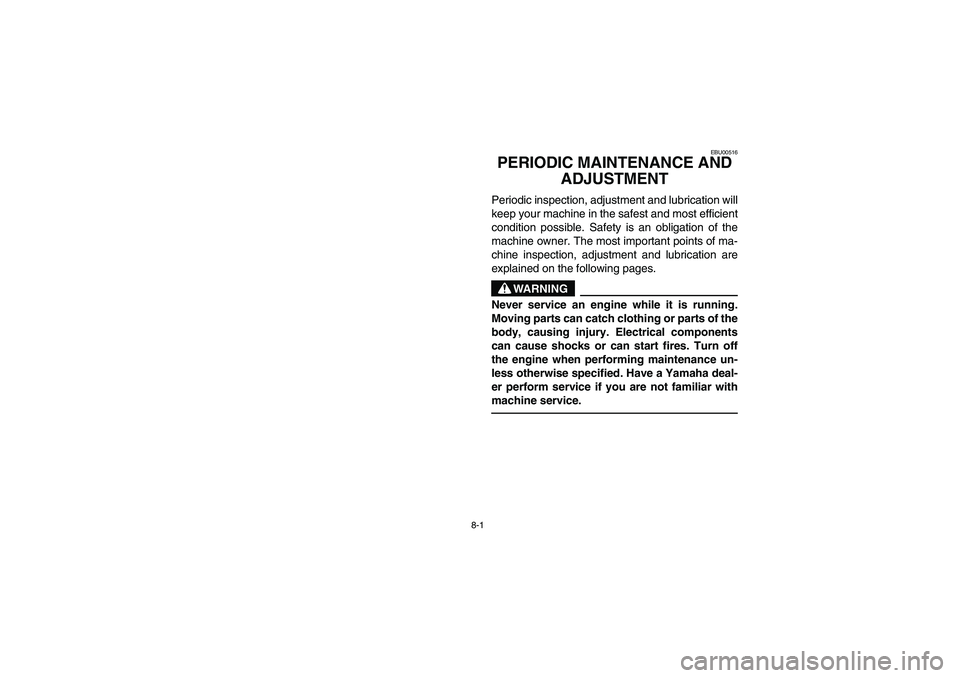
8-1
EBU00516
PERIODIC MAINTENANCE AND
ADJUSTMENTPeriodic inspection, adjustment and lubrication will
keep your machine in the safest and most efficient
condition possible. Safety is an obligation of the
machine owner. The most important points of ma-
chine inspection, adjustment and lubrication are
explained on the following pages.
WARNING
Never service an engine while it is running.
Moving parts can catch clothing or parts of the
body, causing injury. Electrical components
can cause shocks or can start fires. Turn off
the engine when performing maintenance un-
less otherwise specified. Have a Yamaha deal-
er perform service if you are not familiar with
machine service.
U5NF62.book Page 1 Wednesday, May 8, 2002 1:40 PM
Page 250 of 380
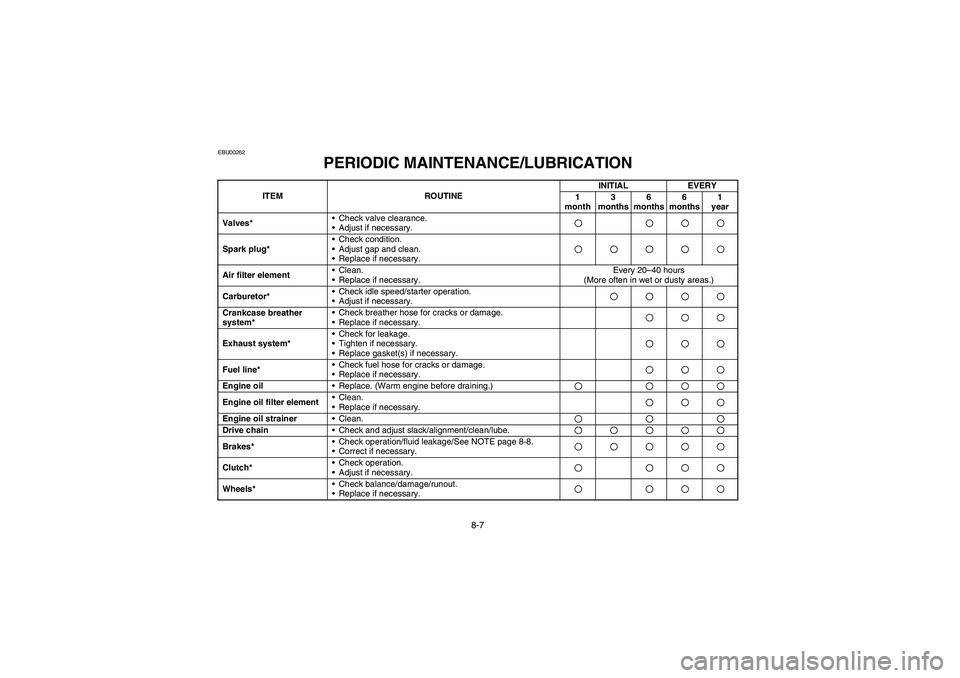
8-7
EBU00262
5-PERIODIC MAINTENANCE/LUBRICATION
ITEM ROUTINEINITIAL EVERY
1
month3
months6
months6
months1
year
Valves*•Check valve clearance.
•Adjust if necessary.
Spark plug*•Check condition.
•Adjust gap and clean.
•Replace if necessary.Air filter element•Clean.
•Replace if necessary.Every 20–40 hours
(More often in wet or dusty areas.)
Carburetor*•Check idle speed/starter operation.
•Adjust if necessary.Crankcase breather
system*•Check breather hose for cracks or damage.
•Replace if necessary.Exhaust system*•Check for leakage.
•Tighten if necessary.
•Replace gasket(s) if necessary.Fuel line*•Check fuel hose for cracks or damage.
•Replace if necessary.Engine oil•Replace. (Warm engine before draining.)Engine oil filter element•Clean.
•Replace if necessary.Engine oil strainer•Clean.Drive chain•Check and adjust slack/alignment/clean/lube.Brakes*•Check operation/fluid leakage/See NOTE page 8-8.
•Correct if necessary.Clutch*•Check operation.
•Adjust if necessary.Wheels*•Check balance/damage/runout.
•Replace if necessary.U5NF62.book Page 7 Wednesday, May 8, 2002 1:40 PM
Page 258 of 380
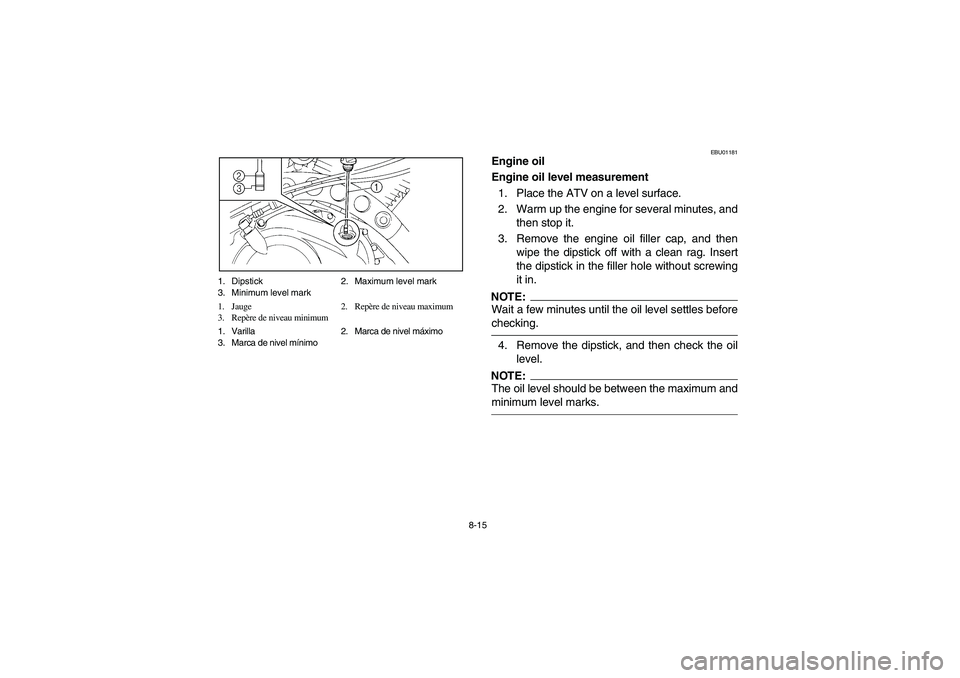
8-15 1. Dipstick 2. Maximum level mark
3. Minimum level mark
1. Jauge 2. Repère de niveau maximum
3. Repère de niveau minimum
1. Varilla 2. Marca de nivel máximo
3. Marca de nivel mínimo
EBU01181
Engine oil
Engine oil level measurement
1. Place the ATV on a level surface.
2. Warm up the engine for several minutes, and
then stop it.
3. Remove the engine oil filler cap, and then
wipe the dipstick off with a clean rag. Insert
the dipstick in the filler hole without screwing
it in.NOTE:_ Wait a few minutes until the oil level settles before
checking. _4. Remove the dipstick, and then check the oil
level.NOTE:_ The oil level should be between the maximum and
minimum level marks. _
U5NF62.book Page 15 Wednesday, May 8, 2002 1:40 PM
Page 260 of 380
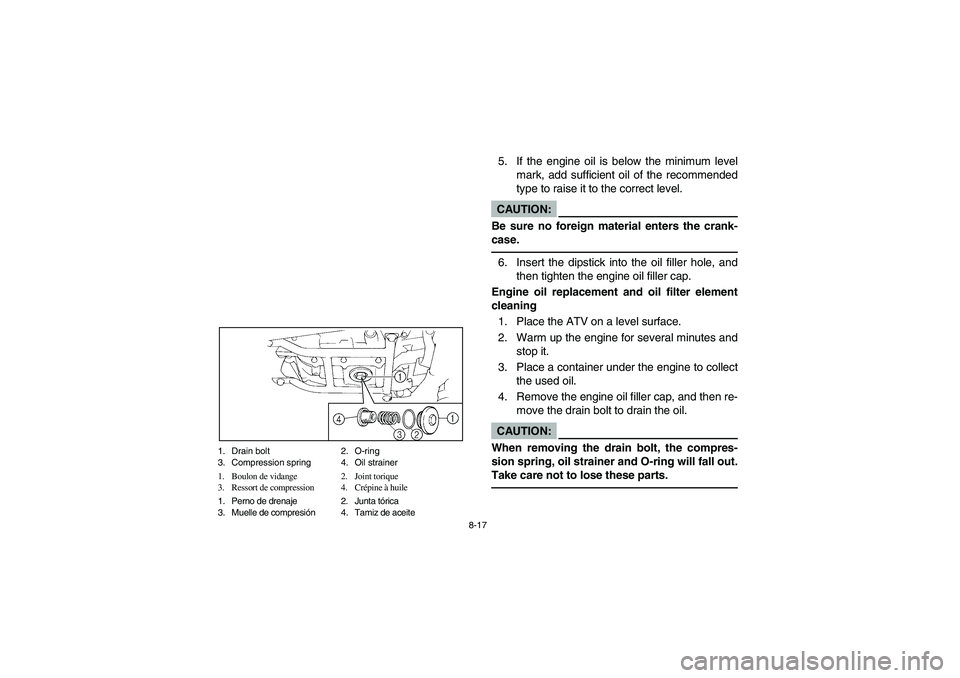
8-17 1. Drain bolt 2. O-ring
3. Compression spring 4. Oil strainer
1. Boulon de vidange 2. Joint torique
3. Ressort de compression 4. Crépine à huile
1. Perno de drenaje 2. Junta tórica
3. Muelle de compresión 4. Tamiz de aceite
5. If the engine oil is below the minimum level
mark, add sufficient oil of the recommended
type to raise it to the correct level.CAUTION:_ Be sure no foreign material enters the crank-
case. _6. Insert the dipstick into the oil filler hole, and
then tighten the engine oil filler cap.
Engine oil replacement and oil filter element
cleaning
1. Place the ATV on a level surface.
2. Warm up the engine for several minutes and
stop it.
3. Place a container under the engine to collect
the used oil.
4. Remove the engine oil filler cap, and then re-
move the drain bolt to drain the oil.CAUTION:_ When removing the drain bolt, the compres-
sion spring, oil strainer and O-ring will fall out.
Take care not to lose these parts. _
U5NF62.book Page 17 Wednesday, May 8, 2002 1:40 PM